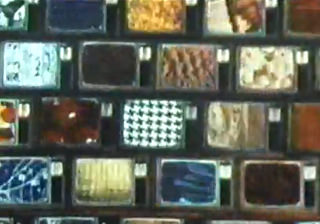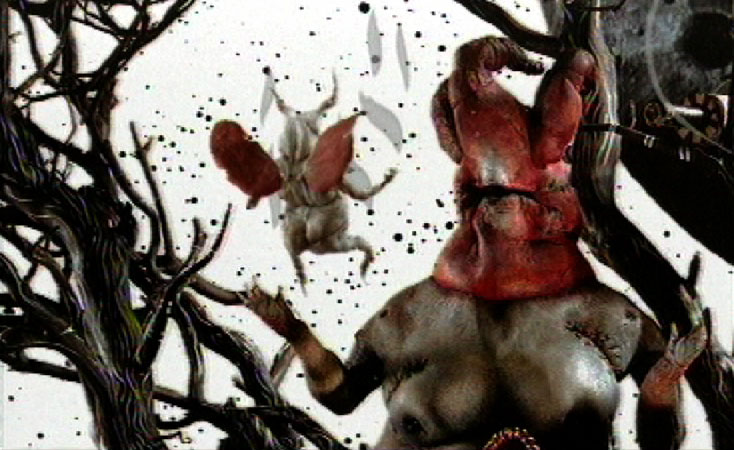Focus
on Piotr Kamler
Piotr
Kamler, born in Warsaw, Poland in 1936, made a number of delightful
animations which create fantastic worlds. His works include
L’Araignéléphant (1968), Délicieuse
catastrophe (1970),
La Planete Verte (1966), Cœur
de secours(1973),
Le Labyrinthe(1969), and Chronopolis.(1977-1982).
He studied Fine Arts in Paris in 1959 and worked with a number of
Musique Concrete composers such as Bernard
Parmegiani, Iannis
Xenakis, François
Bayle and Ivo
Malec.
François
Bayle, born in Madagascar, composed over 100 compositions, his style
was musique concrete, electronic art music. He studied in the 1950s
with Messiaen, Schaeffer and Stockhausen and contributed widely to
the culture of experimental music by arranging concerts, radio
broadcasts, seminars and events in France. He held the position of
head of the Groupe de Recherches Musicales (GRM) which he held until
1997. He then opened his own Studio, Studio Magison.
There's
a great interview with Bayle in 2009, from the Computer Music Journal,
talking about enjoying messing with the stereo placement of sounds,
using many loudspeakers to challenge the listener with their ideas of
space. He looks at acousmatic music and graphic representation of
sounds, amongst other topics.
“In
acousmatic music, one may recognize
the sound sources, but one also
notices that they are out of their usual context. In the acousmatic
approach, the listener is expected to reconstruct an explanation for
a series of sound events, even if this
explanation
is provisional.
Like reading a detective
story, one invents a scenario to find the
chain of causality that explains the situation.” Bayle
THE HEART, or Coeur de Secours
9 min 1973
A Piotr Kamler film
Music: François Bayle
The
use of unusual sounds, placed carefully in the stereo field with
space to hear each sound encourages a curiosity from the listener. I
believe that this approach creates an interesting conversation with
the visual in animation, allowing the viewer to make their own sense
of the piece. In The Heart, the sounds are sparce and textured,
related to the image but not directly echoing the sound effects of
the objects or actions in the film. The opening shot, with the man
on a bike rocking back and forth, then cycling forwards, uses sounds
that reflect the slowness of the movement, the mechanical feel,
perhaps the squeaking of the wheels. There is a tonal line, mostly
static, like a clarinet or bassoon, with percussive clicks and
rumbles. This contrasts the high flute-like notes accompanying the
steps of the man following the woman in the next scene. The pair of
men playing chess have thinking music, random slow notes of wide
intervals, intellectual and thoughtful. The sounds throughout are
sparce and never dominate the visual with overexaggerated emotion or
full frequency washes of sound. The lack of dialogue or narrative
also allows the sounds to exist without becoming less important than the narrative.
Compare
this film to La Planete Verte, also by Piotr Kamler. The soundscape
has some similarities, despite being by Ivo Malec (who incidentally
also was involved in the GRM and worked with Schaeffer). The
experience of watching the film is very different because of the
narrative. Immediately the soundscape is pushed into the background,
the story taking a dominant position. La Planete Verte is also more
classical, with gestures from the orchestra which are recognisable
instruments and sounds, less the electronic sound of Bayle. The
sounds are more prescriptive in relation to the visual, that is to
say that they match the visual more directly than Bayles, they are
less abstract and dreamy.
Another particularly interesting film by Kamler is Le Labyrinthe, the sound done by
Bernard Parmigiani.
It opens with the sound of Tibetan Monks doing
throat singing (or at least extremely low voices), combined with dissonant electronic tones which pulse in and out. A babble of voices
enters as different faces are gradually seen on the same head silhouette shape.
The voices stop, and the tone returns, pulsing in intensity as though
alive. Later we hear the voices entering again at intervals
throughout the piece, like voices in your head, or different
personalities within one person.
Sound
effects like footsteps reinforce the nightmare like quality of this
film, but the soundtrack does not directly follow the visuals in a
prescriptive manner. It is open enough to encourage curiosity, and
sparce enough to hear individual sounds and textures, for example around 2.43 where electronic sounds are like a jungle at night, where the visual texture is
like the sihouette of trees and perhaps veils of leaves. Creatures
hang and move like bats in defined spaces in the frame. But the
sounds are electronic, familiar and unfamiliar, with a gesture
towards a sound effect but mysterious. A shimmering tone accompanies
a solitary man who walks through the landscape.
The
soundtrack builds up tension as the man becomes more agitated and
frantic, reaching a climax at 12.20 with sharp string staccato jabs
as the man moves, stops, then moves in a stuttering repeated rhythmic
pattern, dissonant and tense. The high frequencies are taken out
gradually as the man falls, with still stuttering movements, then the
many faces projected onto the single head move towards the viewer
again with two dissonant tones which are held through changes in the
visual scene. The note remains while we see a square tunnel with a
face gradually lit up, too large for the head silhouette surrounding
it, then a tiny man walks across the head. The music fades and the
film ends.
The
sound track makes the film extremely intense and powerful. It evokes
a sense of madness and being trapped in your head, your mind. Yet it
allows enough room for individual interpretation, silences and
sparce sounds, and enough room to ask questions about the visuals.
The conversation between the visuals and the sound is fascinating,
and quite even in terms of power with neither dominating over the
other.







